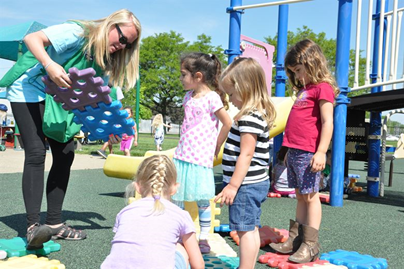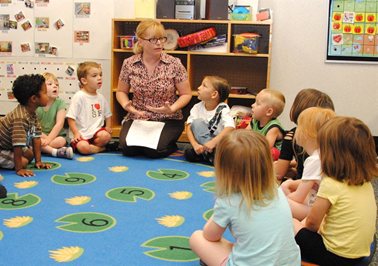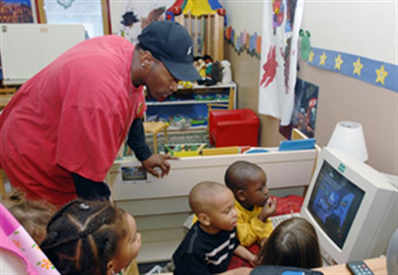7.4: Introducing to the Foundations
The domain of social-emotional development encompasses three areas or strands:
- self
- social interaction
- relationships[1]
Supporting Children’s Developing Self
Early learning deeply engages the self. Most preschool children approach learning opportunities with enthusiasm and self-confidence, excited by the prospect of new discovery. Their successes (and occasional failures) shape their sense of what they can do and sometimes drive their efforts to acquire new skills. Their achievements and occasional disappointments also provoke the responses of others—adults and peers—that further influence children’s self-concept and self-confidence. Young children value learning for themselves because it is valued by the people who matter to them.
In a preschool program, learning is a social activity. Therefore, preschool children’s success in learning depends on their capacity to understand and participate constructively in the social environment. Early childhood is a period of rapid growth in social and emotional understanding in which the children’s capacity for empathy and caring is also developing. This is also a period of growth in self-regulation as young children are acquiring skills for sustaining their attention, focusing their thinking and problem-solving, managing their behavioral impulses, and controlling their emotions. Even so, lapses in self-regulation are as apparent as young children’s successes, and developmentally appropriate expectations for children’s self-control are essential.

Therefore, a thoughtfully designed preschool curriculum that supports social-emotional development devotes considerable attention to the direct and indirect ways that children’s classroom experiences shape the development of self.
The foundations for Self include those for self-awareness, self-regulation, social and emotional understanding, empathy and caring, and initiative in learning:
Self
1.0 Self-Awareness
| At around 48 months of age | At around 60 months of age |
| 2.1 Describe their physical characteristics, behavior, and abilities positively. | 4.1 Compare their characteristics with those of others and display a growing awareness of their psychological characteristics, such as thoughts and feelings. |
2.0 Self-Regulation
| At around 48 months of age | At around 60 months of age |
| 4.2 Need adult guidance in managing their attention, feelings, and impulses and show some effort at self-control. | 2.1 Regulate their attention, thoughts, feelings, and impulses more consistently, although adult guidance is sometimes necessary. |
3.0 Social and Emotional Understanding
| At around 48 months of age | At around 60 months of age |
| 4.3 Seek to understand people’s feelings and behavior, notice diversity in human characteristics, and are interested in how people are similar and different. | 4.1 Begin to comprehend the mental and psychological reasons people act as they do and how they contribute to differences between people. |
4.0 Empathy and Caring
| At around 48 months of age | At around 60 months of age |
| 4.4 Demonstrate concern for the needs of others and people in distress. | 4.2 Respond to another’s distress and needs with sympathetic caring and are more likely to assist. |
5.0 Initiative in Learning
| At around 48 months of age | At around 60 months of age |
| 4.5 Enjoy learning and are confident in their abilities to make new discoveries although may not persist at solving difficult problems. | 4.3 Take greater initiative in making new discoveries, identifying new solutions, and persisting in trying to figure things out. |
Teachers can support children’s development of the Self with the following:
- Provide ample space, use child-sized shelves and furnishings, and adapt materials to make all learning areas and activities accessible
- Designate learning areas to help children select preferred sites for exploration
- Place active play zones away from quiet areas to better support children in their choices for play
- Make use of adaptive tools and play materials to help the autonomous exploration of children with special needs
- Observe individual children attentively during a variety of activities
- Incorporate artwork and play materials that reflect children’s home cultures
- Describe aloud for children observations of what they do and express as they play, explore, and participate in group activities
- Compare aloud children’s past and present abilities as you observe them
- Give specific feedback to children about their efforts
- Use planned activities and children’s own observations to draw attention to people’s similarities and differences, including preferences and feelings
- Set up opportunities to practice problem solving with children who have not yet developed those skills
- Use appropriately stimulating aesthetic elements such as soothing colors, natural woods and fibers, and soft textures
- Eliminate or reduce background noise to help children attend to what you want them to hear
- Model behavior and attitudes that are warm, respectful, and caring
- Maintain developmentally appropriate expectations for preschool children’s behavior
- Guide and coach children’s behavior
- Prompt and guide desired behavior
- Reinforce children’s good choices and link their actions to positive outcomes
- Provide a consistent but flexible daily routine
- Alternate between active and quiet activities
- Time group experiences to match children’s developing attention spans, social skills, and self-control
- Introduce children to relaxation exercises
- Plan developmentally appropriate transitions
- Play games with rules periodically to help children learn to focus their attention and regulate their impulses in order to achieve a goal
- Observe the levels of social and emotional understanding that children already have
- Label the emotions people express and communicate with children about what may be provoking those feelings
- Discuss characteristics openly and answer their questions about differences, being thoughtful to counter stereotypes by using concrete examples
- Make use of the experiences and emotions of characters in stories
- Acknowledge and express appreciation for children’s empathic responses
- Encourage empathy and caring for the natural world, including plants and animals
- Model curiosity and enthusiasm when you learn new things
- Engage in play and exploration with children instead of simply supervising their activities
- Provide ample time for free exploration, scheduling play and exploration periods of at least one uninterrupted hour at a time
- Help children generate ideas for solving problems they encounter
- Model persistence during challenging tasks; explaining that unsuccessful attempts to do something are not failures, but simply steps toward learning what will work[2]

Pause to Reflect
Vignettes
A child in a wheelchair enters the housekeeping area where three children are pretending to be a family. They have dishes on the table and dolls in the doll bed. The child in the wheelchair moves closer to the table and tries to join the play but cannot get close enough. After a few minutes, one of the children takes some dishes and puts them on the wheelchair tray. The two children play together. Mr. Luke comments, “I like your idea to use Andy’s tray as a table.”
Chloe cries in Ms. Julia’s arms. Ms. Julia pats her back softly and communicates in a soothing manner. “It sounds like that hurt. You can tell Paz you don’t like that. Say, ‘I don’t like that, Paz.’” Chloe tucks her injured arm in toward Ms. Julia’s body, shakes her head slowly side to side, and looks out warily at Paz. Paz stands close with her head lowered. “Chloe is upset because you pinched her arm. It hurt her quite a bit. Is there something you think we could do to help her feel better, Paz?” asks Ms. Julia.
Paz responds softly, “Sorry, Chloe,” and reaches forward to give Chloe a hug.
Chloe whimpers and clings more closely to Ms. Julia. “When a friend is hurt, giving a hug often helps. I guess Chloe isn’t ready for a hug right now. Thank you for trying, Paz. Maybe we can ask her again later.”[3]
Supporting Children’s Social Interaction
Group learning always involves social interaction. The ease and skill with which children interact with adults and peers (in a preschool classroom or family child care program) and the competence with which they assume their roles and responsibilities as group members significantly influence how they learn. The development of these skills in the preschool years is a foundation for children’s capacity to be socially skilled and competent classroom members in the primary grades.
For some children, unfortunately, difficulties in social interaction—because children are timid and inhibited, are aggressive or disruptive, struggle with being cooperative, or have physical or behavioral characteristics that often result in them being excluded—can pose significant obstacles to benefiting from social interactions with adults and peers. For them and for all children, attention to social interaction skills can be a significant contribution to preschool children’s learning in early childhood classrooms.

A thoughtfully designed preschool curriculum that supports social-emotional development devotes considerable attention, therefore, to the direct and indirect ways that classroom experiences shape the growth of children’s social interaction skills. This includes interactions with adults, peers, and in groups as well as cooperation and responsibility.
- The California Preschool Curriculum Framework, Volume 1 by the California Department of Education is used with permission ↵
- The California Preschool Curriculum Framework, Volume 1 by the California Department of Education is used with permission; The California Preschool Learning Foundations, Volume 1 by the California Department of Education is used with permission ↵
- The California Preschool Curriculum Framework, Volume 1 by the California Department of Education is used with permission ↵

